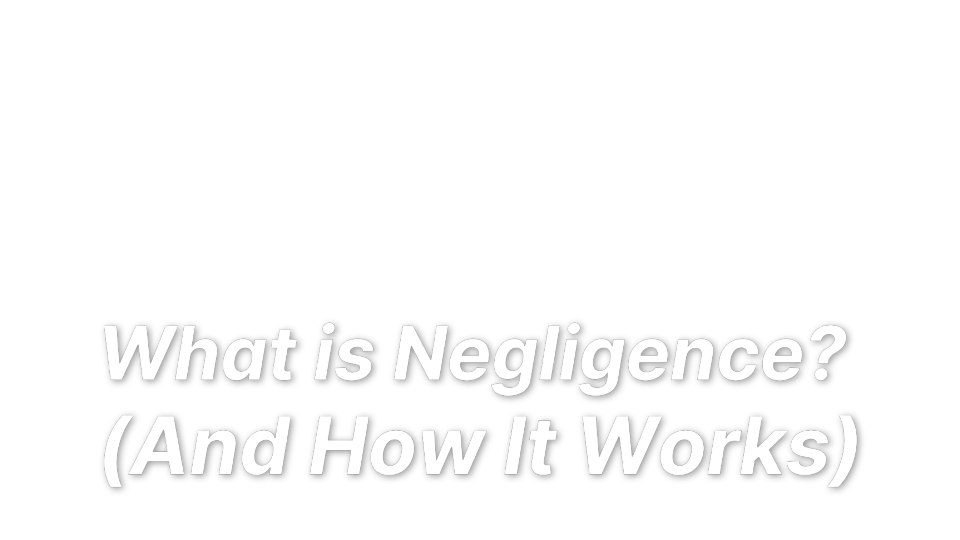
What is Negligence? (And How It Works)
Negligence is a complicated legal term that essentially is defined as an accidental harm. This is an oversimplification, but most forms of negligence harm another individual due to a failure on your part to prevent that harm. Unlike with criminal acts or intentional torts (such as assault and battery or false imprisonment), you don’t intend to commit a negligent act.
Cover Your Business From Claims Of Negligence
Understand your coverage. Request a free quote today.
Get A Callback
Our Offices Are Currently Closed
The Elements Of Negligence
Negligence is made up of four legal elements: (1) duty; (2) breach; (3) causation; and (4) harm. All of these elements must be present in order to meet the requirement for negligence.
Duty: Short for your duty of care, this looks different depending on your relationship with the person. For example, you have a stricter duty of care to your child than to a stranger. Ultimately, we all have a duty to act reasonably at all times to one another. Unfortunately, we don’t have a specific legal definition of what is and isn’t reasonable. If you see a baby drowning in a river and you simply need to reach your arm out to save its life, it is unreasonable to leave it there to drown. However, if you see Olympian Michael Phelps swimming in the river, it is unreasonable to rescue him. This is because he is an excellent swimmer, and any waters that are unsafe for him are surely to be deadly for you.It wouldn’t be reasonable to expect you to go into deadly waters and risk drowning yourself. In short, you have a basic duty to everyone, and this duty can be heightened, but is never lowered.
Breach: If you fail to act reasonably, you have breached your duty. Let’s say you own a pet store and leave bags of pesticides open in the aisles—that is clearly a breach of your duty to your customers. No reasonable pet store owner would put customers, children, and pets in contact with toxic substances.
Causation & Harm: Negligence is not merely the breach of your duty; people act unreasonably all the time and it rarely leads to a lawsuit. You must also show that a person was harmed by this breach of duty, and that the breach of the duty caused the harm. For example, if you leave pesticides in the aisle of your pet store and a dog is hit by a car in the parking lot, you are not liable for negligence. Sure, you have breached your duty to your customers and a dog was harmed on your property, but they are two separate acts; the dog’s death wasn’t caused by your failure to secure the pesticides.
Examples Of Negligence In Business
As a business owner, you have a higher duty of care to your customers than to strangers. One of these duties is to provide a safe environment for customers. If your product or your place of business has hidden dangers because you failed to take proper precautions, you could find yourself being sued for negligence.
One of the most common forms of business negligence is a slip and fall. If no one cleans up a liquid that has been spilled in your store, and then a customer slips on the liquid and falls, this is a classic case of negligence.
Another example of workplace negligence is food poisoning. If you serve unsafe food to a customer, you have committed a negligent act.
More Than One Person Can Be Negligent
Many business owners find themselves saying, sure I made a small mistake, but the customer should have known better. This is the idea of comparative, or contributory, negligence. Contributory negligence is when both the injured party and the person or business they are suing are responsible for the injury. Courts handle this type of case differently, but in every scenario, a percentage of fault is assigned to each party. Then, the court will either award the victim the percentage of money that was NOT their fault, or award whoever was less at fault the entire amount.
Example Scenario: Victim falls in your store and has $10,000 in hospital bills. The court finds that you are 60% at fault and the victim is 40% at fault.
Jurisdiction 1: You pay the victim $6,000 (60%) and the victim will be responsible for the remaining $4,000 (40%).
Jurisdiction 2: You pay the victim the entire $10,000 because you are more at fault than the victim (over 50% at fault).
Contributory negligence is a very complicated legal idea, and it is almost impossible to predict how a court will determine who is more at fault. This increases your risk for ending up on the hook for something you didn’t have much involvement with. You may think that is an unlikely situation, but what happens if the court uses the first type of system (you pay your percentage of fault) and the victim is requesting $10 million? Even if you are only 5% at fault, that leaves you on the hook for $500,000 and could mean the end of your business.
How To Protect Yourself From Negligence Claims
As a human being, you are bound to make mistakes at some point and can’t be expected to prevent all forms of negligence. By the nature of its definition, negligence is unintentional and NEVER planned, which is why the best thing you can do to protect your business from future negligence claims is to find a comprehensive insurance policy. A commercial general liability policy will protect you from most negligence claims, but your industry may require additional safeguards. Give us a call today and one of our experts will discuss your coverage options.
About The Author: Austin Landes, CIC
Austin is an experienced Commercial Risk Advisor specializing in property & casualty risk management for religious institutions, real estate, construction, and manufacturing.



